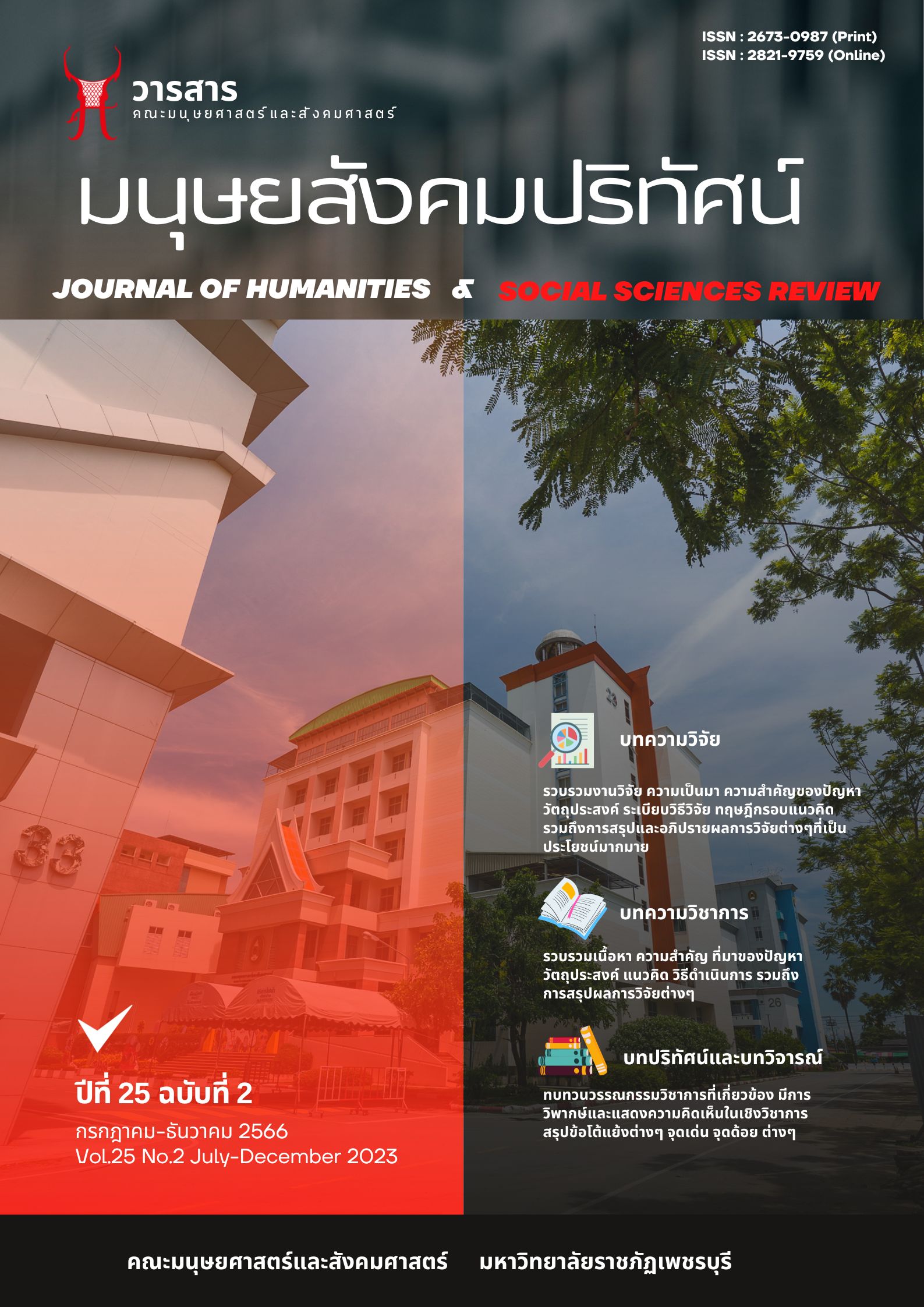การเรียนรู้เชิงรุก Active Learning : กลยุทธ์การสร้างความรู้ด้วยตนเองของผู้เรียน
Main Article Content
บทคัดย่อ
บทความวิชาการนี้มุ่งศึกษาการจัดการเรียนรู้ในระดับอุดมศึกษาที่ต้องการเสนอมุมมองของการจัดการเรียนรู้ที่ไม่ใช่เพียงการบรรยายที่เน้นผู้สอนเป็นศูนย์กลางตามความเข้าใจที่มักจะเกิดขึ้น แต่ต้องการให้เห็นมุมมองของการจัดการเรียนรู้เชิงรุก (Active learning) ที่ผู้เรียนจะสามารถพัฒนาทักษะได้สอดรับกับความต้องการของทักษะในศตวรรษที่ 21 และความต้องการของตลาดแรงงานปัจจุบันและอนาคต ในบทความจึงนำเสนอกระบวนการจัดการเรียนรู้เชิงรุก (Active learning) ประเด็นความหมาย ความสำคัญ แนวทาง การจัดกิจกรรมที่สอดคล้องกับการจัดการเรียนรู้เชิงรุก โดยมีการยกกรณีศึกษาที่เกิดขึ้นจริงในการจัดการเรียนการสอน อีกทั้งยังกล่าวถึงมุมมองของการจัดการเรียนรู้เชิงรุกที่มีฐานสำคัญมาจากทฤษฎีคอนสตรัคติวิสต์ (Constructivist theory) และเสนอแนวทางการประยุกต์ใช้ทฤษฎีในการจัดการเรียนรู้ โดยการศึกษาดังกล่าวนี้ได้ศึกษาข้อมูลจากเอกสาร ตำรา และหนังสือต่าง ๆ รวมถึงกรณีศึกษาที่เกิดขึ้นจริงในการจัดการเรียนรู้ของนักศึกษาสาขาวิชาภาษาไทย ผลจากการศึกษาพบว่า การจัดการเรียนรู้เชิงรุก (Active learning) เป็นกระบวนการที่เกิดขึ้นได้จริงในการจัดการเรียนการสอน โดยเฉพาะในระดับอุดมศึกษาที่มีแหล่งทรัพยากรทั้งภายในและภายนอกมหาวิทยาลัยที่เอื้อประโยชน์ต่อการเรียนรู้ อีกทั้งหลักสูตรในระดับอุดมศึกษาก็เปิดกว้างในการจัดการเรียนรู้ที่จะช่วยเพิ่มสมรรถนะและทักษะสำคัญให้แก่ผู้เรียน โดยเฉพาะทักษะในศตวรรษที่ 21 ทั้งทักษะการเรียนรู้และนวัตกรรม ทักษะสารสนเทศ และทักษะชีวิตและอาชีพ นอกจากนั้นปัจจัยที่สำคัญในการจัดการเรียนรู้ คือ ปัจจัยของผู้เรียนที่ต้องมีความพร้อมในการเรียนรู้ ซึ่งประเด็นนี้บทบาทสำคัญอยู่ที่ผู้สอนจะออกแบบอย่างไรให้ผู้เรียนเกิดแรงจูงใจในการเรียนรู้ดังกล่าว จากการศึกษากรณีตัวอย่างด้านผู้เรียน พบว่า ผู้เรียนค่อนข้างมีความตั้งใจ และสนใจอยู่เป็นเบื้องต้นแล้ว เมื่อครูผู้สอนออกแบบการลงพื้นที่ ออกจากห้องเรียนสี่เหลี่ยมสู่สนามที่กว้างขึ้น สามารถสร้างสรรค์งานได้ด้วยตนเอง ประเด็นนี้คือ แรงจูงใจที่ดียิ่งในการจัดการเรียนรู้ หลังจากนี้ครูผู้สอนจะออกแบบการจัดการเรียนรู้เชิงรุกในลักษณะใดจึงไม่เป็นปัญหา เพราะผู้เรียนมีความพร้อมและสนุกกับการเรียน โดยหัวใจสำคัญสุดท้ายที่ผู้สอนภูมิใจ คือ ผู้เรียนสามารถสร้างความรู้ได้ด้วยตนเอง
Article Details
1. มุมมองและความคิดเห็นใด ๆ ในบทความเป็นมุมมองของผู้เขียน คณะบรรณาธิการไม่จำเป็นต้องเห็นด้วยกับมุมมองเหล่านั้นและไม่ถือเป็นความรับผิดชอบของคณะบรรณาธิการ ในกรณีที่มีการฟ้องร้องเกี่ยวกับการละเมิดลิขสิทธิ์ ให้ถือเป็นความรับผิดชอบของผู้เขียน แต่เพียงผู้เดียว
2. ลิขสิทธิ์บทความที่เป็นของคณะมนุษยศาสตร์และสังคมศาสตร์ มหาวิทยาลัยราชภัฏเพชรบุรีมีลิขสิทธิ์ถูกต้องตามกฎหมาย การเผยแพร่จะต้องได้รับอนุญาตโดยตรงจากผู้เขียนและมหาวิทยาลัยราชภัฏเพชรบุรีเป็นลายลักษณ์อักษร
เอกสารอ้างอิง
กุลิสรา จิตรชญาวณิช. (2562). การจัดการเรียนรู้. กรุงเทพฯ: จุฬาลงกรณ์มหาวิทยาลัย.
ทิศนา แขมมณี. (2552). ศาสตร์การสอน : องค์ความรู้เพื่อการจัดกระบวนการเรียนรู้ที่มีประสิทธิภาพ. (พิมพ์ครั้งที่ 10). กรุงเทพฯ: จุฬาลงกรณ์มหาวิทยาลัย.
วัฒนาพร ระงับทุกข์. (2541). การจัดการสอนที่เน้นผู้เรียนเป็นศูนย์กลาง. กรุงเทพฯ: ต้นอ้อ.
สุมาลี ชัยเจริญ. (2559). การออกแบบการสอน หลักการ ทฤษฎี สู่การปฏิบัติ (พิมพ์ครั้งที่ 2). ขอนแก่น: สาขาเทคโนโลยีการศึกษา คณะศึกษาศาสตร์ มหาวิทยาลัยขอนแก่น.
สุคนธ์ สินธพานนท์ และคณะ. (2562). หลากหลายวิธีสอน…เพื่อพัฒนาคุณภาพเยาวชนไทย. กรุงเทพฯ: ห้างหุ้นส่วนจำกัด 9119 เทคนิคพริ้นติ้ง.
หน่วยศึกษานิเทศก์ สำนักงานคณะกรรมการการศึกษาขั้นพื้นฐาน. (2562). แนวทางการนิเทศเพื่อพัฒนาและส่งเสริมการจัดการเรียนรู้เชิงรุก Active Learning ตามนโยบายลดเวลาเรียนเพิ่มเวลารู้. สืบค้นเมื่อ 20 พฤษภาคม 2566, จาก http://academic.obec.go.th.


